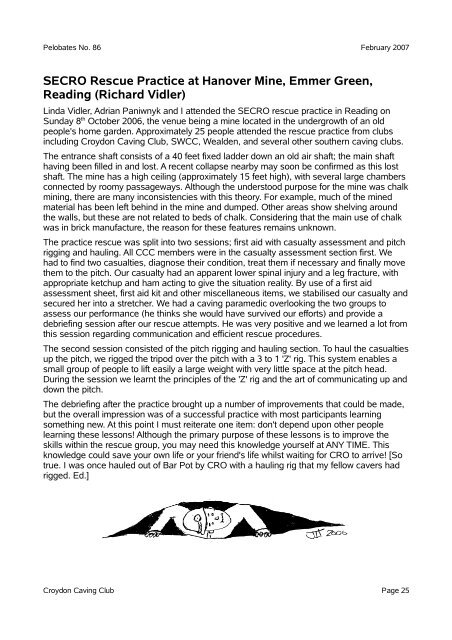Adrian's Explorations (Adrian Paniwnyk)
Adrian's Explorations (Adrian Paniwnyk)
Adrian's Explorations (Adrian Paniwnyk)
Create successful ePaper yourself
Turn your PDF publications into a flip-book with our unique Google optimized e-Paper software.
Pelobates No. 86 February 2007<br />
SECRO Rescue Practice at Hanover Mine, Emmer Green,<br />
Reading (Richard Vidler)<br />
Linda Vidler, <strong>Adrian</strong> <strong>Paniwnyk</strong> and I attended the SECRO rescue practice in Reading on<br />
Sunday 8 th October 2006, the venue being a mine located in the undergrowth of an old<br />
people's home garden. Approximately 25 people attended the rescue practice from clubs<br />
including Croydon Caving Club, SWCC, Wealden, and several other southern caving clubs.<br />
The entrance shaft consists of a 40 feet fixed ladder down an old air shaft; the main shaft<br />
having been filled in and lost. A recent collapse nearby may soon be confirmed as this lost<br />
shaft. The mine has a high ceiling (approximately 15 feet high), with several large chambers<br />
connected by roomy passageways. Although the understood purpose for the mine was chalk<br />
mining, there are many inconsistencies with this theory. For example, much of the mined<br />
material has been left behind in the mine and dumped. Other areas show shelving around<br />
the walls, but these are not related to beds of chalk. Considering that the main use of chalk<br />
was in brick manufacture, the reason for these features remains unknown.<br />
The practice rescue was split into two sessions; first aid with casualty assessment and pitch<br />
rigging and hauling. All CCC members were in the casualty assessment section first. We<br />
had to find two casualties, diagnose their condition, treat them if necessary and finally move<br />
them to the pitch. Our casualty had an apparent lower spinal injury and a leg fracture, with<br />
appropriate ketchup and ham acting to give the situation reality. By use of a first aid<br />
assessment sheet, first aid kit and other miscellaneous items, we stabilised our casualty and<br />
secured her into a stretcher. We had a caving paramedic overlooking the two groups to<br />
assess our performance (he thinks she would have survived our efforts) and provide a<br />
debriefing session after our rescue attempts. He was very positive and we learned a lot from<br />
this session regarding communication and efficient rescue procedures.<br />
The second session consisted of the pitch rigging and hauling section. To haul the casualties<br />
up the pitch, we rigged the tripod over the pitch with a 3 to 1 'Z' rig. This system enables a<br />
small group of people to lift easily a large weight with very little space at the pitch head.<br />
During the session we learnt the principles of the 'Z' rig and the art of communicating up and<br />
down the pitch.<br />
The debriefing after the practice brought up a number of improvements that could be made,<br />
but the overall impression was of a successful practice with most participants learning<br />
something new. At this point I must reiterate one item: don't depend upon other people<br />
learning these lessons! Although the primary purpose of these lessons is to improve the<br />
skills within the rescue group, you may need this knowledge yourself at ANY TIME. This<br />
knowledge could save your own life or your friend's life whilst waiting for CRO to arrive! [So<br />
true. I was once hauled out of Bar Pot by CRO with a hauling rig that my fellow cavers had<br />
rigged. Ed.]<br />
Croydon Caving Club Page 25


